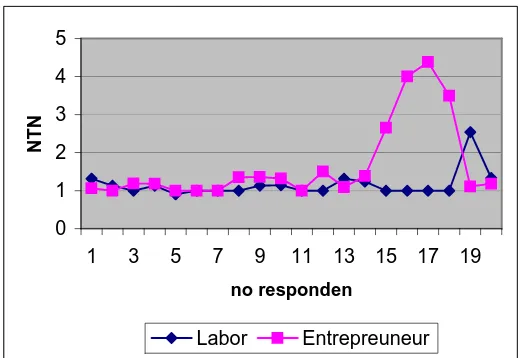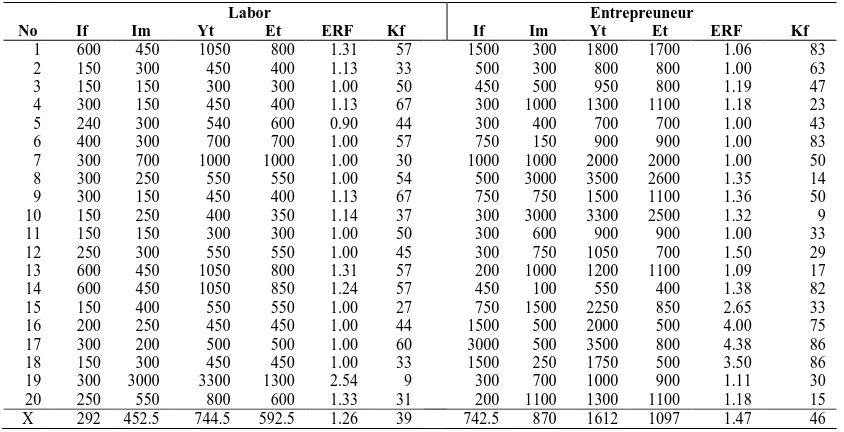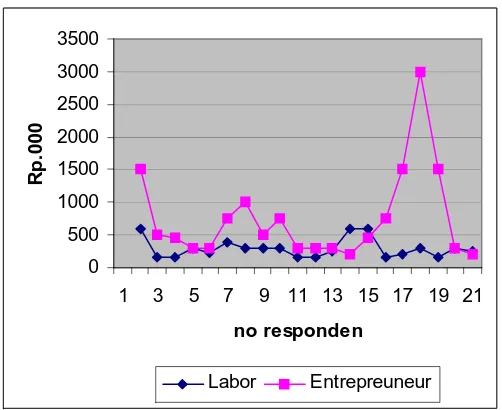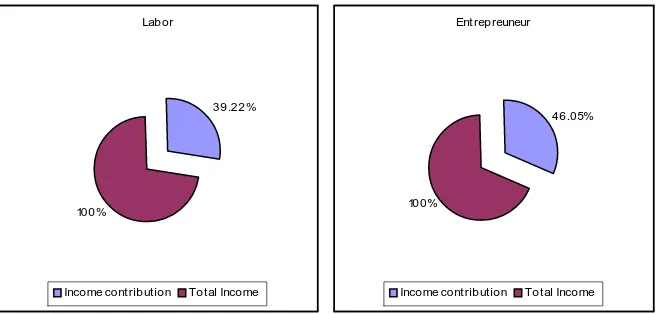Analysis of Family Prosperity and Income Contribution of Fisherman’s Wives at Cilacap Village, Cilacap
16
Original paperANALYSIS OF FAMILY PROSPERITY AND INCOME
CONTRIBUTION OF FISHERMAN’S WIVES
AT CILACAP VILLAGE, CILACAP
Azis Nur Bambang*
Faculty of Fisheries and Marine Science, Diponegoro University Tembalang, Semarang 50275, Indonesia
Received: January 4, 2005 ; Accepted: June 26, 2005
ABSTRACT
The objective of this research is to know level of family prosperity and income of fisherman’s wives and to know amount of income contribution of fisherman’s wives in Cilacap. Case study method was used in this research. Result of research indicates that level of family prosperity of labor fisherman’s wives with ERF = 1,26 is lower compared to level of family prosperity of entrepreneur fisherman’s wives (ERF = 1,47). Income of labor fisherman’s wives Rp.292 000 is lower compared to income of entrepreneur fisherman’s wives (Rp 742 500). Income contribution of labor fisherman’s wives is 39,22 %, while income contribution of entrepreneur fisherman’s wives is 46,05 %.
Keywords: Prosperity, Contribution of income, Fisherman’s wives, Cilacap
*Correspondence: Fax (024)7474698; e-mail : pak_azis @ yahoo.com
I
NTRODUCTION
The area of fishery study is very wide. Fishery study does not only limit to fish in biological meaning but also socioeconomic problems of fisherman. Social study of fishery economics for example includes study of family prosperity of fisherman and fisherman’s income (Heruwati, 2002) Government’s effort to increase activity of development of economics, especially in fishery, aims at increasing living standard of fisherman and at the same time to improve community nutrition, so that the prosperity and income of fisherman‘s
community can increase ( Mangga Barani, 2004).
Generally, fisherman’s wives do not differ from other women, they have problems that share in development such as limited knowledge and skill resulted in low income and their condition of poverty under line. To make the ends meet in family life they take income jobs.
Analysis of Family Prosperity and Income Contribution of Fisherman’s Wives at Cilacap Village, Cilacap
16
The research result of Kusuma-wardhani (2002) in East Java, indicates that generally most of Fisherman’s wives participated in social activities, such as activity of PKK, POSYANDU, KUD,arisan, and economic activities, especially
local economy. Rural women taking part in economic activity because the income of their husbands was not enough to fulfill demand of their family.
When the condition of family economy can not answered the demand requirement of family, fisher’s women will assist to work as peddlers of fish in market, of fish grill at retail or as broker fish, and as labor in small informal sector activities. Based on the above description, the real problem is how far the role of women (both workers and entrepreneur) on the improvement of prosperity and family income. The question is whether they have a good life? Do they have enough family income? Or, their income only enough for basic living, or even they still live under poverty line? Therefore, this study is needed in order to investigate the family prosperity and women’s income as well as to investigate the contribution of their income within their family’s income This research had been conducted for one month, in March 2004, at PPS (Ocean Fish Harbor) in Cilacap village, District of Cilacap, Central Java.
The result of this research is expected to be useful information regarding prosperity level and income of fisherman’s wives, and also input to policy makers determine priority and programs in socioeconomic development, in the effort of human development.
M
ATERIALS AND
M
ETHODS
The study used survey method. Two kinds of data were collected i.e. the primary and secondary data. The primary data were
collected using Participatory Rapid Appraisal (PRA)‘s technique (Daniel, 2002). Respondents were sampled using Stratified Random Sampling; number of respondents calculated by using formula (Suparmoko, 1985) as follow:
n =
Number of fisherman’s wives population in sub-district of Cilacap counted 1035 persons who consist of 471 labors and 564 entrepreneurs. The total respondents of 40 persons were selected by sampling method from women fishers; they were classified into labors and entrepreneurs, each category consisted of 20 respondents.
Data Collecting
Primary data collecting were taken by direct interview and observation. The survey applied structured and not structured questionnaires, in order to take deeper valid information related to this research ( Nur Bambang, 2003).
While the secondary data were taken documents related to the study. Secondary data regarding the amount of residents, work, age and education level were obtained and collected from Monography
Sub-District of Cilacap. While the
secondary data concerning fishery information were taken from Marine and
Fisheries Office Cilacap.
Data Analysis
Analysis of Family Prosperity and Income Contribution of Fisherman’s Wives at Cilacap Village, Cilacap
16
1. Prosperity level analyses usesExchange Rate Fisherman formula (ERF) according to Nikijuluw and R.Basuki (2001), which runs
ERF =
non fisheries activity (Rp.)
EFt = Total expenditure of fisherman in
fisheries (Rp.)
EKt = Total expenditure of fisherman
for the consumption of family (Rp.) t = Period of time ( month)
2. Income contribution analyses of fisherman’s wives uses formula ( Nur Bambang, 2002 ) as the following
Kf = man’s wives to income of family
If = Income of fisherman’s wives Im = Income of husband
Io = Income of other sources
R
ESULTS AND
D
ISCUSSION
General condition
District of Cilacap represents coastal region of south central Java, which consist of fishery catch and fishery products. Fishery catch in Cilacap is supported by many facilities, like fishing ports and fish landing centre (PPI), Fish Auction Place (TPI) and Port of the Ocean Fisheries (Pelabuhan Perikanan Samudra). Fish
Auction Place represents basis landing of fish, loading and unloading of ships in PPS (Port of the Ocean Fisheries) at Cilacap Harbor (Dinas Kelautan dan Perikanan Cilacap, 2003).
Sub district of Cilacap area has 171.364 Ha consisting of 85 RT and 15 RW, and 4.448 KK (family head). Total of resident is 15.876 persons, 7.932 men and
Result of secondary data analysis indicated that fisherman’s women exist in the study area comprises labors and persons who do not work. Labor population of fisherman’s women in district of Cilacap is 1035 persons who consist of 471 labors and 564 entrepreneurs
Table 1. explains all respondents are 20
years old and more, split into to types of livelihood,labors and entrepreuneurs. The lower level of education population in coastal area region is common phenomenon as in all Indonesia region.
Result of research concerning education of fisherman’s women (Tabel
2), indicates that most of them passed
Analysis of Family Prosperity and Income Contribution of Fisherman’s Wives at Cilacap Village, Cilacap
16
Table 1. The Age and Types of Livelihood
Age (years old)
Respondents / Fisherman’s wives
Labor Entrepreneur
Source: Research result in 2004.
Table 2. Respondents Education
Level of Education
Respondents / Women Fisherman
Labor Entrepreneur
Source: Research result in 2004.
Prosperity of and entrepreneur labor respondents, as expressed in Exchange Rate Fisherman (ERF = Nilai Tukar
Nelayan) in March 2004 presented at Fig 1 and Table 3. Prosperity of labor fisherman
women family have ERF around 1 that is with average value is 1,26. This value indicates that most of labor income are can only to answer the demand of requirement of its life
Analysis of Family Prosperity and Income Contribution of Fisherman’s Wives at Cilacap Village, Cilacap
16
While Exchange Rate Fisherman (ERF) of entrepreneur fisherman equal to 1,47 , bigger than ERF of labor fisherman (only 1,26), the income of most entrepreneur fisherman family is enough to fulfill of primary needs; even 4 entrepreneurs or 25% of the samples have enough prosperity level. Its means they have potency to meet basic needs demand or they have opportunity to make saving, especially for entrepreneurship who have ERF values greatest 2 (two)
Table 3. Result of Enumeration ERF, Income, and Income Contribution of Labor compared
and Entrepreneur
Boldness :
If = Income of fisherman’s women X = Mean
Im = Income of husband
Yt =Total pendapatan nelayan (Rp 000/bulan).
Et =Total pengeluaran nelayan (Rp.000/bulan).
Yt = Total [of] income of fisherman (Rp.000 / months). Et = Total of] expenditure of fisherman (Rp.000 / month). ERF = Exchange Rate Fisherman (Nilai Tukar Nelayan)
Kf = Income contribution of fisherman women to income of family
According to Nur Bambang (2002) the role women activities will be able to improve live standard and prestige of human being. Fisherman‘s women participate to maintain the continuity of family life, by having role as wife and also as income earner for the family like assisting husband in selling fish, as processor of fish and other activities related to fisherman’s life.
According to Heruwati (2002), women basically have important role in household economy. They sacrifice time and energy in taking double roles in domestic sector and trade. Even women are capable to be self-supporting having equal position with men in making decision. The role of women as individual can be seen from her ability to make decision, especially for those who became
Labor Entrepreuneur
No If Im Yt Et ERF Kf If Im Yt Et ERF Kf
1 600 450 1050 800 1.31 57 1500 300 1800 1700 1.06 83
2 150 300 450 400 1.13 33 500 300 800 800 1.00 63
3 150 150 300 300 1.00 50 450 500 950 800 1.19 47
4 300 150 450 400 1.13 67 300 1000 1300 1100 1.18 23
5 240 300 540 600 0.90 44 300 400 700 700 1.00 43
6 400 300 700 700 1.00 57 750 150 900 900 1.00 83
7 300 700 1000 1000 1.00 30 1000 1000 2000 2000 1.00 50
8 300 250 550 550 1.00 54 500 3000 3500 2600 1.35 14
9 300 150 450 400 1.13 67 750 750 1500 1100 1.36 50
10 150 250 400 350 1.14 37 300 3000 3300 2500 1.32 9
11 150 150 300 300 1.00 50 300 600 900 900 1.00 33
12 250 300 550 550 1.00 45 300 750 1050 700 1.50 29
13 600 450 1050 800 1.31 57 200 1000 1200 1100 1.09 17
14 600 450 1050 850 1.24 57 450 100 550 400 1.38 82
15 150 400 550 550 1.00 27 750 1500 2250 850 2.65 33
16 200 250 450 450 1.00 44 1500 500 2000 500 4.00 75
17 300 200 500 500 1.00 60 3000 500 3500 800 4.38 86
18 150 300 450 450 1.00 33 1500 250 1750 500 3.50 86
19 300 3000 3300 1300 2.54 9 300 700 1000 900 1.11 30
20 250 550 800 600 1.33 31 200 1100 1300 1100 1.18 15
Analysis of Family Prosperity and Income Contribution of Fisherman’s Wives at Cilacap Village, Cilacap
16
entrepreneur women. The labors could work in processing of fish, (like fish salting, labor processor of briny fish), fish-net labor ( treatment and repair of fish-fish-net) and also household labor. While becoming entrepreneur women, generally they work in processing of fish, merchant (ish broker), or open a small-shop.Income Contribution Rp.150.000 - Rp.600.000 per month, for 4- 8 hour work per day. Those who worked as labor of fishing-net could earn Rp.150 000 to Rp.300 000.
Fig. 2. Income of Labor compared to Entreupreurneur
Labor in processing of fish could obtain wage. One reason is that they did not work every day and their wage really depended on their skill. Income of labor fisherman women is lower than that of entrepreneur fisherman women, caused by difference of education, experience, skill, ability and ownership of capital. Capital owned by labor is only energy or service.
Most women of entrepreneur obtained income more Rp.750.000 per month. Incomes of some entrepreneur women who worked as merchant of fish or held a shop could reach millions of rupiah per month (Table 3 and Fig. 2).
Most entrepreneurs became fish merchant or fish processor from self experience, self apprenticeship or hereditary. According to Farida (2002), motivation pushing fisherman’s women to work was economic pressure, assisting husband and look for additional income of family.
Analysis of Family Prosperity and Income Contribution of Fisherman’s Wives at Cilacap Village, Cilacap
16
Labor
39.22%
100%
Income cont ribution Total Income
Ent repreuneur
46.05%
100%
Income cont ribution Total Income
Fig. 3. Income Contribution of fisherman’s women
C
ONCLUSION
Prosperity level of family of labor fisherman’s women with ERF = 1,26, is lower compared to entrepreneur fisherman’s women which is in ERF = 1,47. Income of labor fisherman’s women Rp.292 000 is lower compared to income of entrepreneur fisherman’s women which is Rp.742 500 due to differences of education, experience, skill, ability and ownership of capital. Capital had by labor only energy or service.
Rate of income contribution of labor fisherman’s women = 39,22% is lower compared to entrepreneur fisherman’s women which is 46,05%. Although income contribution of labor women is smaller than entrepreneur women, this income contribution can be meaningful to increase living standard and prosperity of fisherman’s family.
It is suggested that there should be some trainings especially on fisheries related skills and entrepreneurship for these women in order to improve their knowledge on trading. Therefore, they will be able to improve their role in increasing family’s income and prosperity.
R
EFERENCES
Daniel, M. 2002. Research Method of
Socio Economic. PT. Bumi Aksara.
Jakarta.165 p. (in Indonesian).
Dinas Kelautan dan Perikanan, 2003.
Annual Report. Marine and Fisheries
Office Cilacap Regency . 67 p. (in Indonesian).
Farida, 2002. The Analysis Role of
Employment Women in Traditional Fish Processing at Tanjung Mas
Village, Semarang. Tesis
(unpublished). Post Graduate Program UNDIP. Semarang, 195 p. (in Indonesian)
Heruwati,E.S.,2002. Traditional Fish
Processing: prospect and
opportunities for development. J. Indon. Agri. Res. Dev. XXI : 3:
92-99.
Kelurahan Cilacap, 2004. Village Monograhic. Cilacap Village Office,
Analysis of Family Prosperity and Income Contribution of Fisherman’s Wives at Cilacap Village, Cilacap
16
Kusumawardhani, G. 2002. IncomeContribution of Fisherman’s Wiwe at Tambakrejo Village, District of
Sumbermanjing Wetan, Malang
Regency. East Java. Paper presented
at Seminar. Faculty of Fisheries and Marine Science, UNDIP. Semarang, 16 p. (in Indonesian)
Mangga Barani, H. 2004. Fisheries
Catching in Indonesia: Present and future. Final report Seminar for
Promotion of Sustainable Development of Fisheries in Indonesia. ICA, ICFO dan IKPI. Jakarta. 161-170.
Nikijuluw, V. dan R.Basuki, 2001. Guiden
Concept of Exchange Rate
Fisherman. BRKP-DKP. Jakarta
35-53. (in Indonesian).
Nur Bambang, A. 2002. Economic
Empowerment for Coastal
Communities (PEMP) in Kebumen
Regency. Mitra Adi Pranata.
Semarang, 167 p. (in Indonesian).
Nur Bambang, A, 2003. Validity and
Reliability. Paper for TOT Widya Iswara. 29-November – 4 December
2003. BPPI. Semarang. (in Indonesian).
Suparmoko, 1985. Research Practice
Method: for Socio and Economic Science. BPFE. Yogyakarta. 294 p.
(in Indonesian).
Susastra, IW. and M.Suryadi, 2004.
Analysis of Family Prosperity and Income Contribution of Fisherman’s Wives at Cilacap Village, Cilacap



